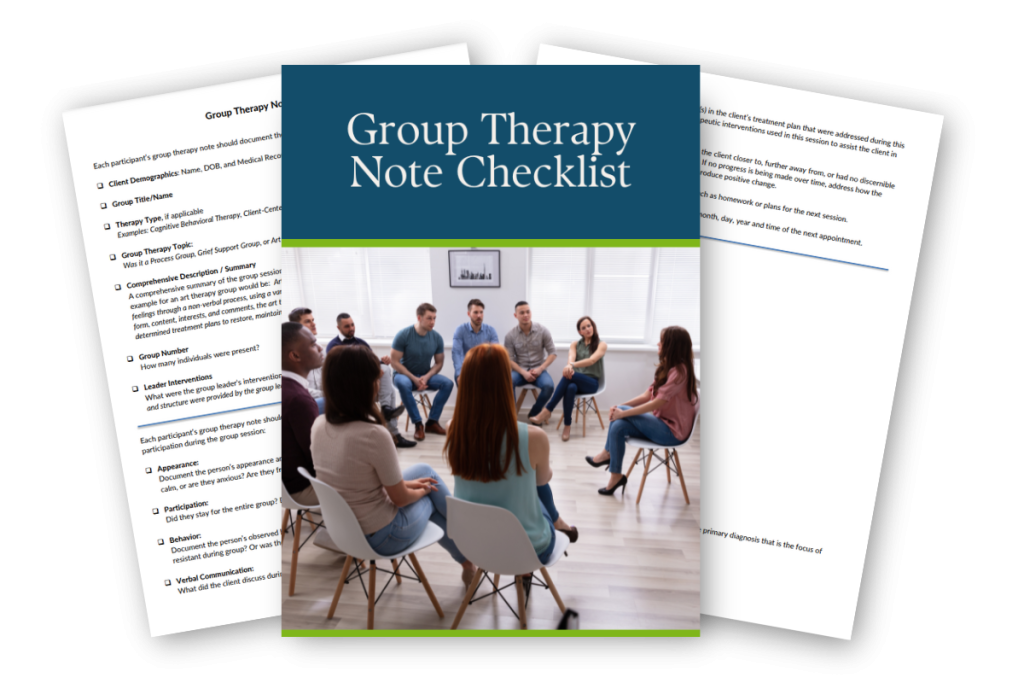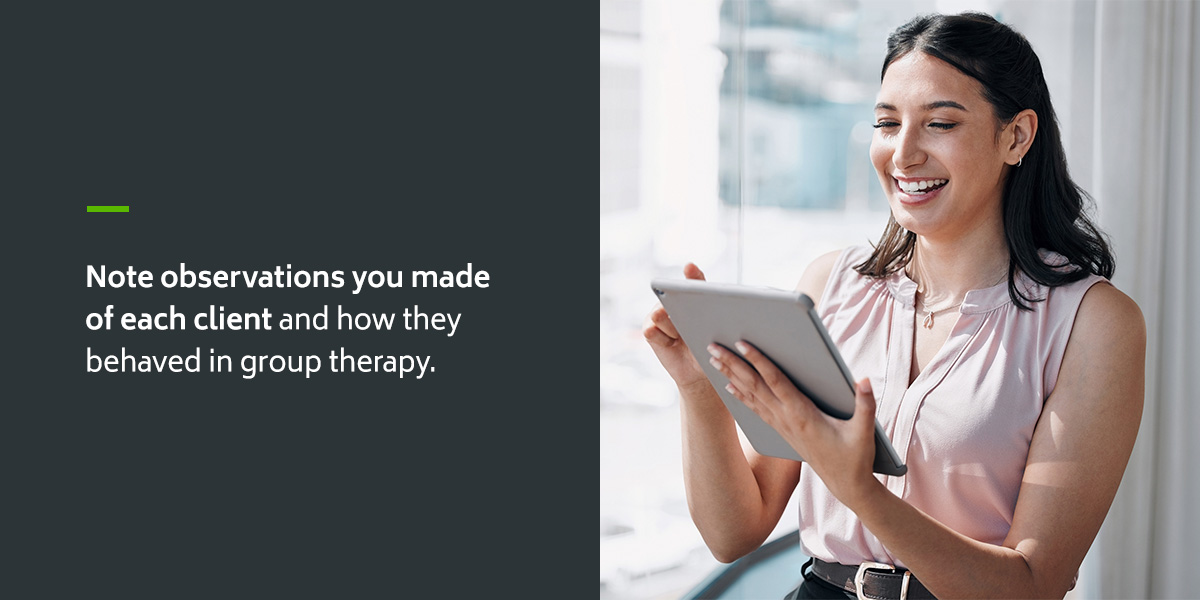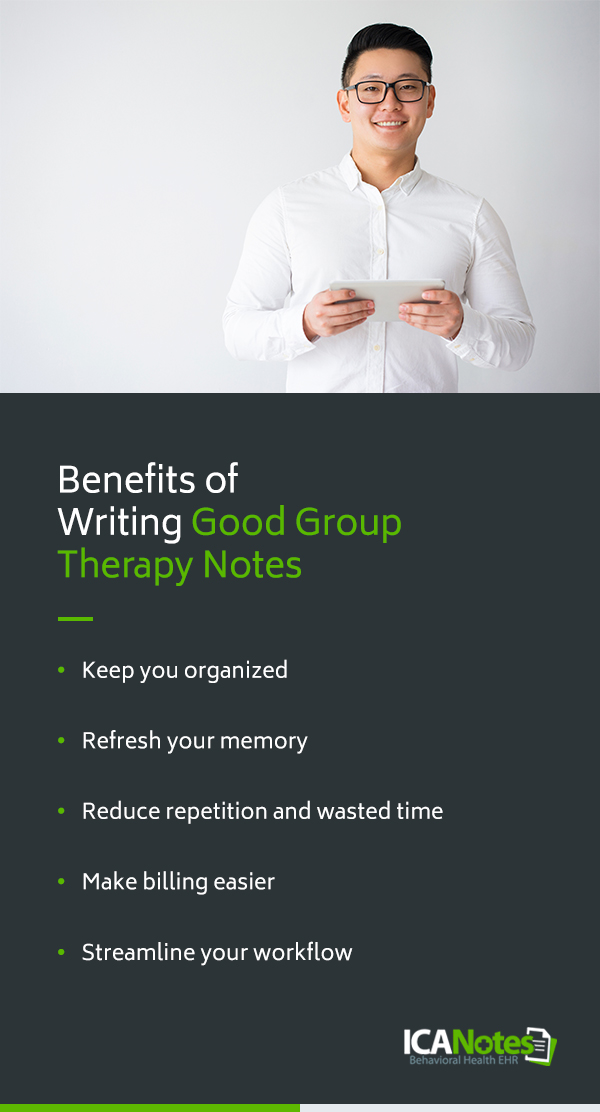
How to Create a Group Therapy Note
Group therapy provides a unique outlet for participants to interact and gain insight from one another, all under the guidance of a counselor. One of the most important aspects of your job as a group therapy counselor or therapist is detailing the key details of your session regarding your patients' treatment plans. Some insurers may require you to conduct group therapy before they will reimburse you, but this depends on your practice. A group therapy note is also a critical component of each client's medical record and can enhance their mental health care.
If you're starting to offer group therapy sessions or considering adding this service to your practice, you may be wondering how to write group therapy notes. This post will explain what to include in a group therapy note and provide a few tips for writing better notes.
Table of Contents
Free Download: Group Therapy Note Checklist

What is a Group Therapy Note?
A group therapy note is a type of progress note. It focuses on how a group therapy session helps clients reach their treatment goals and describes their participation. In general, you'll need to write an individual note for every person who participates in the group therapy session to prove medical necessity and get reimbursed. Each note will start with an overall summary of the group's discussion topic and the interventions used, followed by the client's response to the session and how the meeting addressed their treatment goals.
Differences Between Group Therapy Notes and Individual Notes
Group therapy notes and individual therapy notes have a few differences. First and foremost, your group notes will consider your patient's interactions with you and other members of the group, while individual therapy only focuses on the patient-therapist relationship. Additionally, the Health Insurance Portability and Accountability Act (HIPPA) and the American Psychological Association only provide detailed guidelines for individual therapy notes when it comes to privacy and confidentiality rules.
For group therapy, on the other hand, there are not many requirements available. However, it's still important that you follow certain best practices and professional guidelines when writing your notes. You can even apply your individual therapy standards to group therapy with a few tweaks, such as:
- Creating a separate record for each group member
- Using initials for other group members when writing interactions to avoid breaches of confidence
- Writing general notes about group interactions and interventions to include in each member's progress notes
The most significant difference between individual and therapy notes is that you must record individual and group interactions. These differences are similar to those between progress and psychotherapy notes. With progress notes, you are usually legally obligated to share these notes with your client or other clinicians if necessary or requested. Likewise, a group therapy progress note is a more formal document related to each patient's treatment plan.
Meanwhile, process or psychotherapy notes are more freeform notes that are generally meant for the therapists' eyes only. HIPPA grants special protection to these notes so they can be your private thoughts, impressions, and thoughts about your session or patient's behavior.
The Elements of a Group Therapy Note
Overall, group therapy notes are not much different than the progress notes you write for individual client sessions. For example, you can use the SOAP (an acronym for Subjective, Objective, Assessment, and Plan) note format for individual group therapy notes, just as you would for regular progress notes. The difference is you'll include a brief group summary at the top of each note and incorporate details about the session throughout the document.
Regardless of the note-writing format you use, be sure to describe the client's participation in the group, how they reacted to the session, and how the meeting addressed their treatment goals.
To help you get started, here are 12 essential elements to include in individualized group therapy notes.
1. Group Summary
Each note for individual clients should begin with a group synopsis. You might include the following details:
- The group's name
- The discussion topic
- The session's date
- The session's start and stop time
- The session's schedule
- The counselor's name
- The number of clients in attendance
- The interventions used
You can use the same group summary for each client. If you do so, make sure it does not include individual client names. You might create an attendance list and file it in a separate folder.
2. Identifying Information
Ensure each note includes accurate identifying information such as:
- The client's full name
- The client's identification number
- The client's date of birth
- Your organization's name
Depending on your practice, you may need to include a few other details, such as the client's gender or contact information.
3. Mood and Appearance
Include the client's observed or reported mood. Also, note the client's overall appearance and anything that stands out. You might use a mental status exam checklist to help you describe a client's mood and appearance.
4. Behavior
Did the client participate in the group discussion? Did they share their feelings with others or offer their insights? Note observations you made of each client and how they behaved in group therapy, including their response to other group members and any personal experiences they shared.
5. Issues and Events
Describe any new issues the client presented during the session or problems they had with another group member. For example, if a client becomes angry and argues with another group member, describe how you intervened and helped them identify the source of their anger.
6. Patient-Group Interactions and Reactions
In each group member's notes, you'll want to describe how they interacted with the group and how the group reacted or interacted with them. Discuss how they engaged with the group and the contributions they made. Do they assume the role of the group leader or are they more passive and timid? Is the group receptive and welcoming to the individual or do they have difficulties integrating and accepting them into the discussion?
7. Patient-Group Influences
Next, report on the patient-group dynamics in terms of influence. Every individual member will play a different role in how the group functions as a whole. Detail how each of your patients contributed or influenced the group. For instance, did they have a significant effect on the direction of the conversations or topic? Did they have a heavy influence on the tone of the overall interaction?
As you should describe how each client influenced the group, you should also explain how the group influenced each client. Describe the nature of how the group did this and the effect it had. Did the group's support positively influence the client and make them feel encouraged about the possibility of change? Did the group's agreement or disagreement on a particular topic affect the client or make them feel excluded? Was the group able to change the patient's mind about a specific issue?
8. Goals and Objectives
Document the goals and objectives in each client's treatment plan that you addressed during the group therapy session. For instance, imagine a client's goal is to stop abusing alcohol. They have several objectives in their treatment plan to help them achieve this, such as identifying triggers that lead to their alcohol use. Include this specific objective if the group therapy session focuses on identifying substance use triggers.
9. Therapeutic Intervention
List the interventions you used during the session to target a client's goals and objectives. For example, you might write that you taught the group a breathing exercise to help members reach their goal of feeling less anxious.
10. Response or Progress
Write how the client responded to the session and whether it helped them get closer to their goals. Include if the session moved the client away from their objectives or made no impact. For example, you might add that a client listened to the group's feedback but did not seem interested in applying their suggestions. If the client does not eventually make progress, you may want to include how you will change your strategy.
11. Plan and Additional Information
Describe the client's plan for future sessions and the homework you assigned. Use this section to mention if a client will miss the next session and explain why. Include any strategies the client learned during group therapy that they plan to apply while they're absent.
12. Signature and Date
Include your signature, credentials, time, and date. If needed, get your supervisor's signature as well. You might also add the time and date of the next group therapy session.
How to Write Better Group Therapy Notes
Like individual progress notes, group therapy notes should be accurate, detailed, and easy to read. Well-written notes reduce the likelihood that your insurance claims will get denied. They also help you monitor a client's overall progress and develop effective treatment plans. Here are a few tips to help you write quality group therapy notes.
1. Use Objective Language
Be sure to write your group therapy notes using an objective tone. You don't want to interject anything that could suggest a bias toward any specific participant. Any opinions need to remain focused on client's problems and progress, avoiding wording a reader could interpret as judgmental.
2. Keep Notes Confidential
All clinical documentation must stay confidential to comply with ethical guidelines and the Health Insurance Portability and Accountability Act, including group therapy notes. Ensure each client's notes do not include the names or other identifying information of other group members.
3. Be Clear and Concise
If multiple professionals are running your group, your notes will be the main element in continually driving progress. Others will need to understand the specifics of past meetings, allowing them to pick up and continue therapy seamlessly. Ensure you have clearly stated your analysis of the current session and that the discussed plan for progress is easy to understand.
4. Use Methods and Interventions
Describe any methods, techniques, or interventions you used in the session. These could be things like open-ended questions, exercises, meditations, affirmations, or other strategies you use to help your patient or group achieve a goal. For example, based on the topic of the group discussion, you might help your patients come up with a plan that each person can apply to their personal circumstances and include these details in your notes.
While you may develop these methods and interventions on your own, you can also encourage your patients to help create unique interventions they think might help them accomplish their personal and common goals outside the therapy room.
Regardless of what types of methods or interventions you use, your notes should always align with HIPPA guidelines to protect your clients and your practice. Even though HIPPA — and your practice — may not have specific requirements about group therapy notes, they contain critical and personal information about your patient so they should be treated with the utmost respect and privacy.
5. Maintain Efficiency When Note Writing
Writing better group therapy notes requires focusing on organization and efficiency. When completing your notes, consider your usual process and determine if there are any areas for improvement. If you usually don't write your notes until hours after your session, you'll likely forget many important details. Try to write your notes during or immediately after each appointment, if possible, so your notes will be completed sooner and you won't have to think back about what you discussed.
If you need some time to decompress after each session before you tackle your group therapy notes, try not to wait too long before getting them started. By getting your notes done as soon as possible, you can reduce the time you spend on documentation. You may even feel less frustrated because the appointment will be fresh in your mind.
Another key to efficiency when writing group therapy notes is to know what critical information you need to include before you even start writing. If you're inclined to give a long, descriptive account of each session, you will likely spend hours on your notes, particularly if you have many clients.
Using templates can help you keep your notes organized, clear, and concise, especially when they're tailored to your patient's presenting condition, such as substance use disorder, or the treatment plan you're using. Remember, more detail doesn't mean more accuracy, and longer notes will only usually make it more difficult for you to sift through them later when you're reviewing. Stick to the most essential details and topic of the session as much as possible.
Group Therapy Note Examples
When writing your group therapy notes, it's always helpful to use a therapy note template that keeps them organized, concise, and relevant to the topic of your session. One of the most commonly used templates in therapy is the SOAP method, as mentioned above, which includes:
- Subjective: Include statements or quotes your patient gave during the group session. Use a few sentences to describe the most pressing concern or issue they brought up during the discussion. If the individual refers to another person in their life or the group, use only their initials. Discuss their complaints, symptoms, or life events in their own words.
- Objective: Detail objective, factual, and observable information, such as the patient's demeanor, appearance, or body language. Avoid using personal opinions or judgments. Use this section almost as if you were conducting a physical examination of your patient.
- Assessment: Summarize your assessment of your patient's diagnosis by combining your subjective and objective data to determine what they mean. You can include screening results, goals, interventions, and objectives you addressed in group therapy for this individual.
- Plan: Describe your plan for your patient going forward and include any tasks you assign them during your group session. List any exercises or homework you want them to complete between now and your next group therapy appointment. Report whether your client needs an adjustment to their treatment plan or a referral.
Benefits of Writing Good Group Therapy Notes
Now that you've seen a group note example and know how to take more effective, clear notes, let's review some of the top benefits of improving your note-writing process:
- Keep you organized: Using a template and knowing exactly what information you need to record before you begin writing your notes can prevent you from spending hours searching for the right documents later on.
- Refresh your memory: As a therapist, you may have dozens of clients that you see weekly, especially during group sessions. Writing organized notes makes it easy to review each patient's current progress before starting your group therapy so you can jump right back where you left off.
- Reduce repetition and wasted time: Without following a format for your notes, it can be easy to repeat yourself and spend more time restating the same details you've already written. Writing more efficient notes means reducing documentation time overall by focusing only on key information.
- Make billing easier: Keeping your notes accurate, legible, and detailed enough to comply with insurance companies' requirements may make it easier and faster for you to get paid.
- Streamline your workflow: Having a solid note-writing process can help you spend more time with your patients and less time worrying about when you'll be able to fit in documentation time. Writing your notes more quickly and efficiently may allow you to focus more on other critical tasks in your practice.
Write Streamlined Therapy Notes With ICANotes EHR Software
Group therapy sessions offer a valuable way for those facing similar challenges to find a community of support. As the therapist and moderator of group therapy sessions, your ability to accurately document each client's behavior and progress will help them become who they want to be. Implementing a thorough method for recording group notes plays a significant role in the process.
ICANotes' electronic health record software can help behavioral health professionals take customized, comprehensive group therapy progress notes efficiently and accurately. To learn more about how our therapy software can help you create better notes in less time, contact our team at 866-847-3590 today or request your free trial to get started.
Start a Free Trial Today
Related Posts





